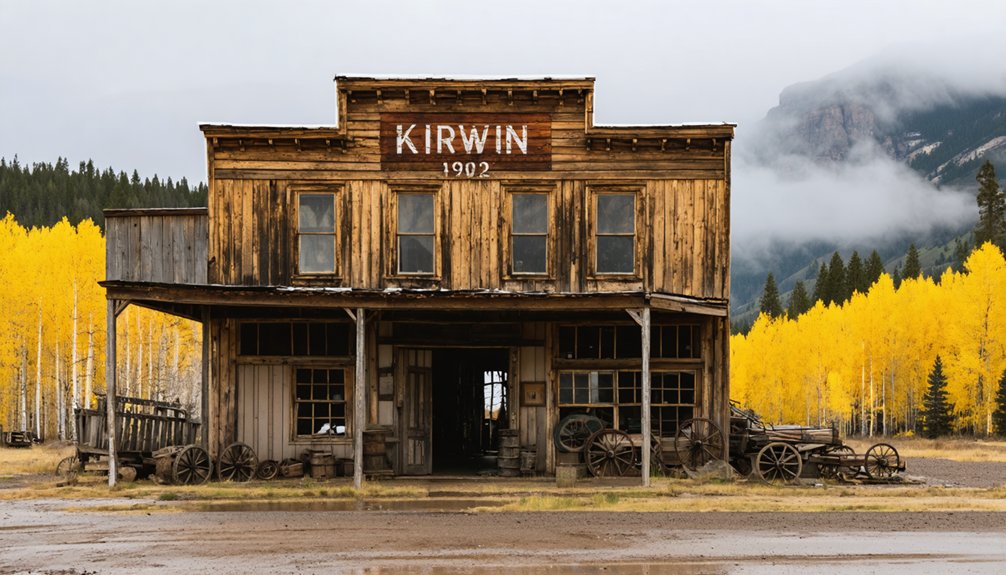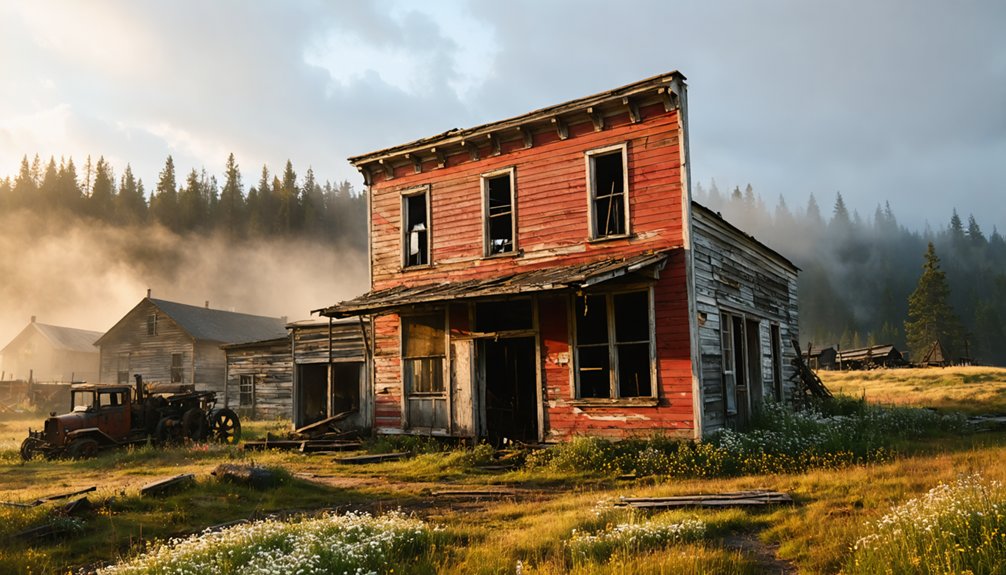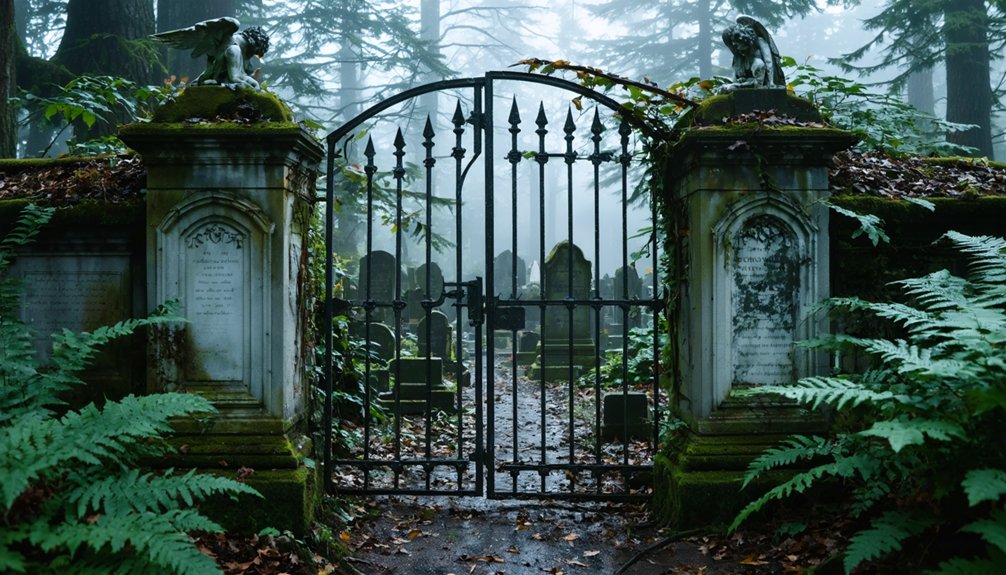You’ll discover the Pacific Northwest’s most fascinating ghost towns across Idaho, Oregon, and Washington. Step back to the 1860s-1900s gold and silver rushes in Silver City’s 70 original buildings, explore Shaniko’s “Wool Capital” boardwalks, or wander Monte Cristo’s preserved mining equipment. From Sumpter’s massive dredge to Liberty’s operational historic machinery, these well-preserved sites offer tangible connections to frontier life. Each town holds untold stories within their weathered walls.
Key Takeaways
- Silver City, Idaho retains 70 original buildings from the 1860s, including the historic Owyhee County Courthouse built in 1867.
- Sumpter, Oregon features well-preserved mining structures, including the iconic Sumpter Valley Dredge and historic buildings from its gold-rush heyday.
- Chesterfield showcases 27 original Mormon pioneer structures, including a meetinghouse built with 85,000 hand-fired red bricks.
- Shaniko’s historic buildings and connecting boardwalks remain intact from its early 1900s era as the “Wool Capital of the World.”
- Monte Cristo offers fifteen preserved structures and mining equipment, accessible via hiking trails with views of North Cascade peaks.
Silver City: Idaho’s Crown Jewel of Mining Heritage
When the Jordan Party discovered gold in Idaho’s Owyhee Mountains in 1863, they couldn’t have known their find would lead to one of the West’s most enduring ghost towns.
Silver City’s mining heritage began in earnest after the discovery of silver in 1864, quickly growing into a bustling town of 2,500 residents with 75 businesses and advanced amenities like telegraph service.
The historic Owyhee County Courthouse, built in 1867, still stands as a testament to the town’s prominence during the mining boom.
The town thrived with eight different saloons and numerous other establishments during its peak prosperity in the 1880s.
You’ll find some of the most authentic Old West architecture here – about 70 original buildings from the 1860s still stand, largely untouched by commercialization.
While the mines produced over a million dollars annually in their heyday, it’s the town’s preservation that makes it remarkable today.
You can walk the same streets as 19th-century miners, explore historic structures, and experience one of America’s best-preserved mining communities.
Shaniko: Oregon’s Time Capsule of the Old West
Deep in Oregon’s high desert lies Shaniko, a remarkably preserved ghost town that once earned the title “Wool Capital of the World.”
After its incorporation in 1901, this bustling hub of the Columbia Southern Railroad grew to 600 residents and became Wasco County’s fifth-largest city.
Today, you’ll find a living representation of Oregon’s wool heritage, with several historic buildings maintaining their Old West charm. In 1903, the town’s wool industry generated a staggering $3 million profit. Summer visitors can explore when local shops reopen for peak tourist season.
The town’s transformation into a ghost town began in the 1910s when the Oregon Trunk Railway bypassed it, though it’s not completely abandoned.
- Visit the impressive Shaniko Hotel, listed on the National Register of Historic Places
- Explore authentic boardwalks connecting preserved structures like the jail and post office
- Join the annual Wool Gathering celebration hosted by the Preservation Guild
Monte Cristo: A Hidden Gem in Washington’s Cascades
You’ll discover a wealth of preserved mining equipment along Monte Cristo’s hiking trails, which lead to the historic ruins through a scenic 10-mile round trip from Barlow Pass.
The lead-silver ore transported by rail to Everett helped fuel the region’s industrial growth. The concentrator mill processed up to 300 tons daily of ore during its peak operations in the 1890s.
The site retains traces of its 1890s mining heyday, including rare patented tramway systems and underground mine breakrooms that were innovative for their time.
While exploring the ghost town’s fifteen remaining structures and relics, you’ll need to follow Leave No Trace principles to help protect this significant piece of Pacific Northwest mining history.
Historic Mining Equipment Remains
Monte Cristo’s mining remnants persist today, nestled deep in Washington’s remote North Cascades wilderness. Historical two-bucket aerial tramways once transported ore at these mountain mining sites.
Access Through Scenic Trails
Beyond the rusted mining equipment lies one of Washington’s most enchanting ghost town trails, leading adventurous hikers to Monte Cristo.
You’ll begin your journey at Barlow Pass on the Mountain Loop Highway, following a historic mining road that winds along the South Fork Sauk River. While trail accessibility remains moderate with about 700 feet of elevation gain over 4 miles, you’ll need to navigate around sections where floods washed out bridges in 2003 and 2006.
The scenic views are worth every step, as you’re surrounded by dramatic North Cascade peaks and dense forest. Once a thriving community of one thousand residents, Monte Cristo showcases the rise and fall of Washington’s mining era.
Trail markers guide you through the 8-mile round trip, though you’ll want to time your visit during summer months when snow and mud won’t impede your progress to this remarkable piece of mining history.
Sumpter: The Golden Days of Oregon Mining
When gold was discovered in Sumpter, Oregon in 1862, few could have predicted the dramatic transformation that would reshape this remote valley into one of the Pacific Northwest’s most prosperous mining towns.
As gold mining evolved from simple placer operations to massive dredging enterprises, Sumpter’s population swelled to 5,000 residents, with 35 mines yielding an impressive $9 million in gold. The dredging operations processed up to seven yards per minute of earth to extract the precious metal.
You’ll find these remarkable remnants of the golden era:
- The iconic Sumpter Valley Dredge, now preserved as a State Heritage Area
- Historic buildings from the boom years when the town bustled with hotels and saloons
- Three massive dredge tailings fields spanning 8 miles across the valley
Today, thanks to historical preservation efforts, you can explore one of America’s last remaining giant gold dredges, a symbol of the region’s rich mining heritage.
Liberty: Washington’s Pioneer Gold Rush Legacy
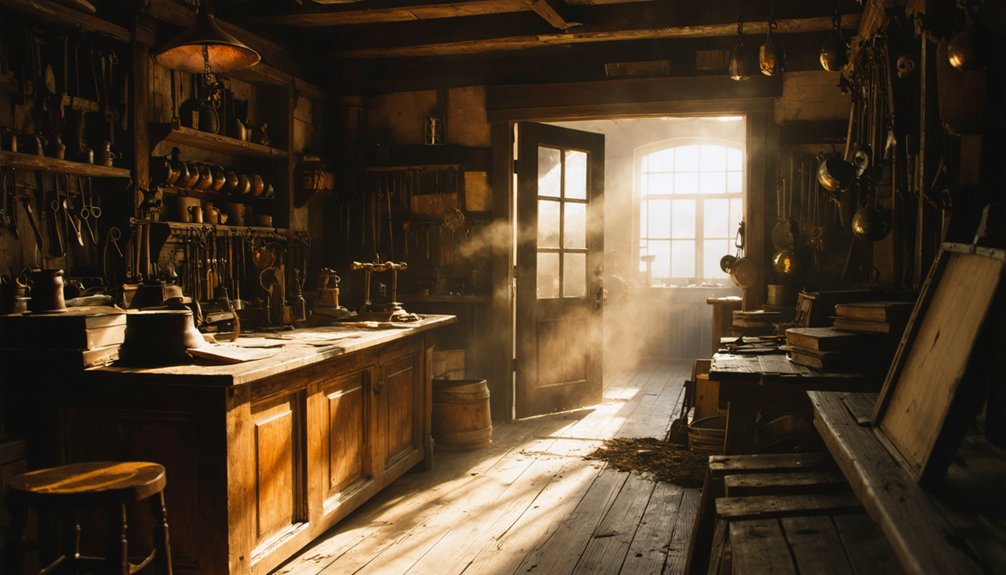
The frontier spirit of gold prospecting etched an even deeper mark in Washington state, where Liberty stands as the territory’s oldest mining townsite. Following gold’s discovery in Swauk Creek in 1873, this remarkable settlement evolved from two sites – Old Liberty and Meaghersville – into a thriving hub for local homesteading families who’d mine for three generations.
What sets Liberty apart is its distinctive mining community stability and specialized gold nugget techniques. Miners focused on extracting coarse placer gold near bedrock, eventually adopting hydraulic mining and dredging methods.
You’ll find it’s not your typical abandoned ghost town – it’s still alive. Now listed on the National Register of Historic Places, Liberty preserves its mining heritage through operational historic equipment and original structures, offering you a genuine glimpse into Washington’s golden past.
Chesterfield: Mormon Pioneer Settlement Frozen in Time
When you visit Chesterfield, you’ll find 27 remarkably preserved original structures dating from 1884 to 1904, including a hand-fired brick meetinghouse that served as the settlement’s central gathering place.
Within these buildings, you can explore how Mormon pioneers structured their daily routines around religious worship, community events, and frontier agricultural work.
The Brook Mercantile and surrounding homes showcase the distinctive Mormon architectural style of the period, with hand-fired brick construction techniques that have withstood more than a century of harsh mountain weather at 5,400 feet elevation.
Mormon Architecture Remains Standing
Standing as a tribute to Mormon pioneer ingenuity, Chesterfield’s remarkably preserved architecture showcases 27 original structures from the late 1800s, including an imposing meetinghouse built with 85,000 hand-fired red bricks.
You’ll discover the enduring legacy of Mormon settlement through these masterfully preserved buildings, laid out in a rigid town grid that exemplifies typical frontier planning.
Since 1980, when Chesterfield earned its spot on the National Register of Historic Places, the Chesterfield Foundation has worked to protect these architectural treasures.
- The meetinghouse now serves as a Daughters of Utah Pioneers museum
- The amusement hall, tithing office, and granary still stand in their original locations
- Most brick structures were built between 1884 and 1904, representing the settlement’s peak period
Pioneer Life Daily Routines
Life within Chesterfield’s well-preserved buildings once followed a strict daily rhythm that began before sunrise.
You’ll find evidence of how men and boys tackled heavy farm work – milking cows, feeding livestock, and cleaning barns – while women managed the household duties of cooking, cleaning, and washing.
Pioneer chores extended to everyone, with children gathering firewood, fetching water, and helping with younger siblings.
The settlement’s grid layout fostered strong community support, as families lived close enough to help during harvests, barn-raisings, or emergencies.
You can imagine neighbors rushing to aid those who fell ill or needed extra hands.
Together, they maintained gardens, shared labor for large projects, and created a lifestyle that balanced hard work with the mutual care essential for frontier survival.
Bodie: Washington’s Preserved Mining Relics
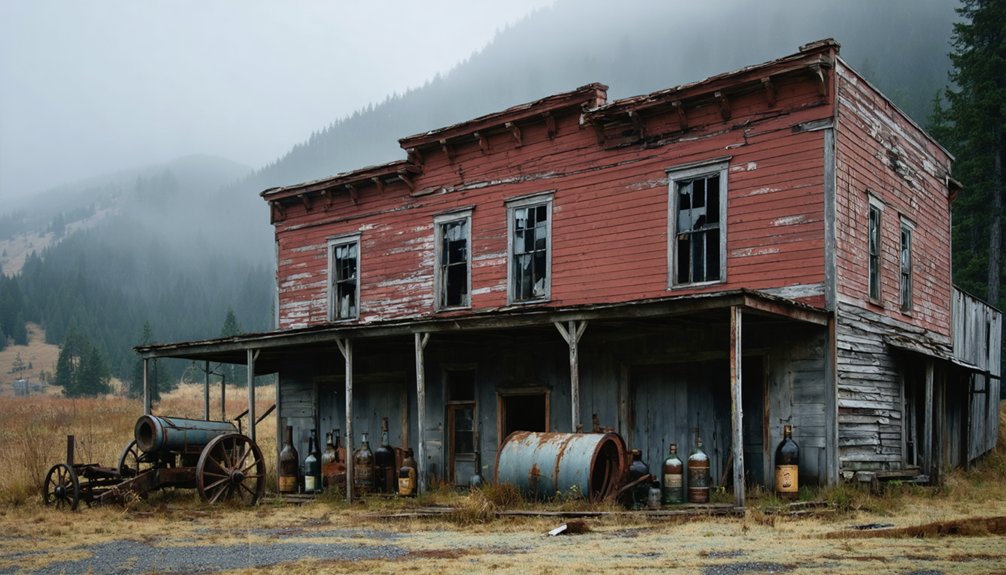
Located in northeastern Okanogan County, Washington, Bodie stands as a tribute to the region’s rich mining heritage.
Deep in Washington’s Okanogan County, Bodie’s weathered remnants whisper tales of the region’s golden mining past.
You’ll find this historic site along Toroda Creek Road, just 12 miles north of Wauconda, where Bodie’s relics tell the story of a classic boom-and-bust mining town that flourished from 1888 to the 1940s.
- The town’s mining operations yielded $1,250,000 in gold before closing due to World War II restrictions in 1941.
- You can explore well-preserved remnants on both sides of Toroda Road, including original cabins, foundations, and mining equipment.
- The site remains protected as a historic landmark, though the mines and some structures are on private property requiring permission to visit.
Bodie history comes alive through its scattered artifacts and crumbling storefronts, offering you a genuine glimpse into the American West’s rugged mining era.
Bayhorse: Idaho’s Silver Mining Showcase
While gold initially drew prospectors to the area in 1864, Bayhorse’s destiny changed dramatically with the discovery of rich silver deposits in 1872.
By 1877, large-scale mining operations were in full swing, with the town producing over 6.3 million ounces of silver and 37 million pounds of lead by 1898.
You’ll find remarkable ghost town architecture throughout the site, including stone charcoal kilns, a hillside stamp mill, and various mining structures that housed up to 400 residents during its peak.
Though a devastating fire in 1889 accelerated its decline, Bayhorse’s mining legacy lives on through its well-preserved ruins.
Since 2006, when Idaho purchased the property, you can explore this authentic ghost town within the Land of the Yankee Fork State Park, where guided tours and informational signage bring the past to life.
Molson: Washington’s Early 20th Century Mining Town
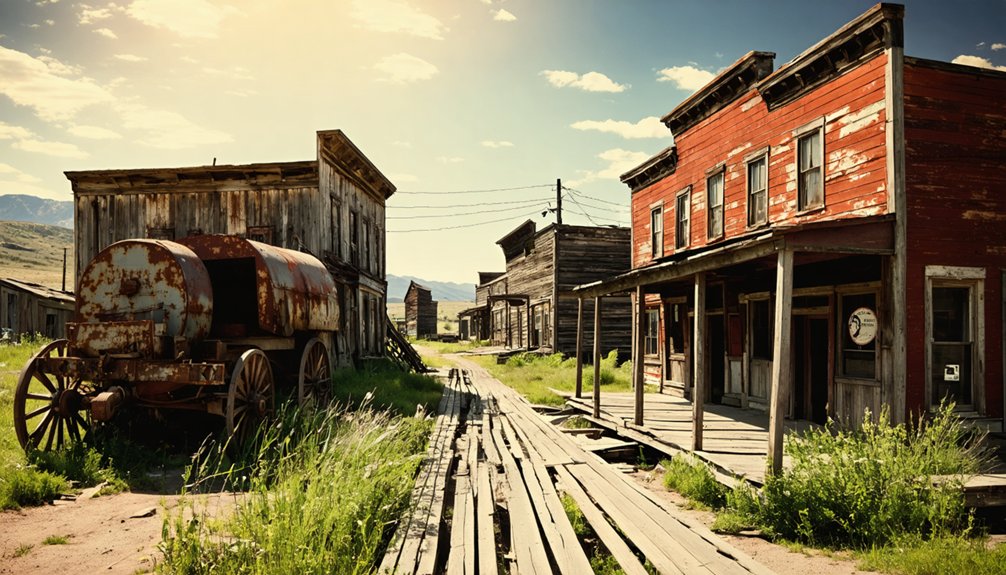
Frontier dreams and Canadian capital collided in 1900 when George B. Meacham and John W. Molson established a mining town just south of the Canadian border.
With a $170,000 investment (worth $6.5 million today), Molson briefly flourished before land disputes forced residents to relocate, creating Old and New Molson.
Today, you’ll find one of Washington’s best-preserved ghost towns, featuring the Old Molson Ghost Town Museum established in 1960.
You can explore this fascinating piece of mining history through:
- Original structures including the Molson bank, pioneer cabins, and a historically accurate schoolhouse
- Authentic mining tools and artifacts that tell the story of frontier life
- Year-round access to outdoor exhibits and period-accurate buildings maintained by local volunteers
Though its population peaked at 300 before plummeting during the Great Depression, Molson’s legacy endures as a demonstration of the region’s mining era.
Govan: The Enduring Schoolhouse Story
In Govan’s two-room schoolhouse, built in 1905, you’ll find a testament to rural education that served eight grades of local children until its closure in 1942.
When you visit today, you’ll see a deteriorating structure with a collapsed steeple, broken windows, and peeling paint – stark evidence of the town’s dramatic decline after the school district merged with nearby Wilbur.
The schoolhouse’s weathered walls tell a poignant story of how a once-thriving agricultural community transformed into one of Washington’s most notable ghost towns, where education and community life once flourished but now stand silent.
Rural Education Legacy
Standing as a tribute to rural education‘s golden age, Govan’s weathered schoolhouse tells the story of a once-thriving Washington farming community established in 1889.
Until its closure in 1967, this institution served as more than just a place of learning – it was the heartbeat of local rural education and community gatherings, connecting students to the region’s agricultural and railroad economy.
Experience the echoes of rural American schooling through these preserved features:
- Original multi-grade classroom layout with large windows for natural lighting
- Traditional late 19th-century architectural design (minus the collapsed 2019 steeple)
- Historic location amid still-functioning grain elevators, showcasing the intersection of education and agriculture
Today, while the structure slowly yields to time, it stands as a powerful reminder of Pacific Northwest rural education’s evolution from local schoolhouses to centralized systems.
Tragic Town Decline
When flames engulfed much of Govan in 1927, they ignited more than just buildings – they sparked the town’s tragic descent into abandonment.
You’ll find this once-bustling railroad depot’s economic shifts mirrored in its crumbling structures, where peeling paint and broken windows tell tales of lost prosperity.
The construction of U.S. Route 2 dealt another blow, redirecting crucial traffic away from Govan’s heart.
As agricultural practices evolved and farming viability diminished, the community decline accelerated.
By 1967, both the school and post office had shuttered their doors forever.
Today, with just three residents remaining as of 2019, Govan stands as a haunting reminder of how quickly a town’s fortunes can change when its economic foundation erodes.
Frequently Asked Questions
Are Camping Facilities Available Near These Ghost Towns?
You’ll find camping options near most PNW ghost towns, from RV parks to dispersed sites. Check local camping regulations before setting up, and you can explore nearby attractions within walking distance.
What Wildlife Hazards Should Visitors Be Aware of When Exploring?
You’ll need to watch for black bears, mountain lions, and rattlesnakes during wildlife encounters. Keep your distance, make noise while walking, and carry bear spray for safety precautions.
Do Any Ghost Towns Offer Guided Night Tours?
Step into the shadows where history whispers – you’ll find nightly ghost tours in Portland’s Shanghai Tunnels, Seattle’s Pike Place Market, and Oregon City’s historic district, with professional guides leading supernatural explorations.
Which Ghost Towns Are Wheelchair Accessible?
You’ll find Molson’s historical significance most wheelchair accessible, with its open-air museum layout letting you view buildings from outside. Monte Cristo offers limited access on a flat, one-mile section near Barlow Pass.
When Is the Best Season to Photograph These Historic Sites?
Like a painter’s palette, summer and fall offer you the best lighting conditions. You’ll capture golden hours from June through October, with rich seasonal colors and dramatic shadows.
References
- https://www.rvoutwest.com/episodes/13-ghost-towns-across-the-pacific-northwest
- https://www.youtube.com/watch?v=HpgbZjxjtxM
- https://stateofwatourism.com/ghost-towns-of-washington-state/
- https://www.youtube.com/watch?v=gx9r_aKZZ2s
- https://bestofthenorthwest.com/northwest-travel-ideas/northwest-ghost-towns/
- https://secure2.pbase.com/mad_monte1/ghost_towns_of_the_pacific_northwest
- https://www.nationaldaycalendar.com/lists/12-oregon-ghost-towns
- https://csr.hdsupply.com/public/browse/Download_PDFS/ghost towns of the pacific northwest.pdf
- https://en.wikipedia.org/wiki/List_of_ghost_towns_in_Washington
- https://westernmininghistory.com/towns/idaho/silver-city/
